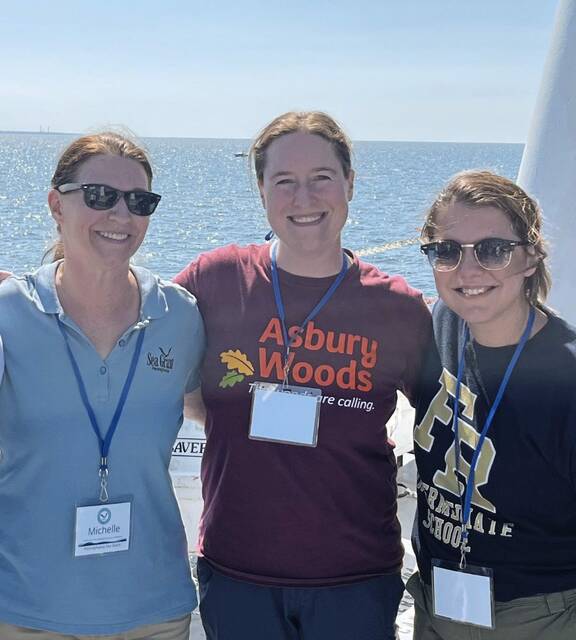Franklin Regional teacher returns from scientific expedition on Lake Erie
Franklin Regional Intermediate School science teacher Brienne May thought she understood the problem micro-plastics posed to the environment.
Then she took a look through the lens of a microscope, at what appeared to be a completely empty petri dish full of water from Lake Erie.
“I saw a rainbow of different colors of micro-plastic,” she said. “I was shocked.”
May was part of a group of researchers who spent July 7-13 aboard the research vessel Lake Guardian operated by the U.S. Environmental Protection Agency. There, they worked alongside the crew, marine technicians, scientists and fellow researchers as part of the EPA’s Great Lakes National Program, which brings scientists and educators to help with research on all the American Great Lakes.
Lake Erie has between 60 and 70 research points which are marked, so that research teams can collect data from the same location and observe changes over time. May said her trip included stops at between 15 and 20 of those points.
“We were looking at cyanobacteria, which can cause some of the harmful algae blooms that Lake Erie has experienced, we were studying benthic organisms — the animals that live on the bottom of the lake bed — and my group was focusing specifically on micro-plastics,” she said.
May’s group dragged a net beside the boat for 30-minute stretches, collecting solids as water is sifted through.
“We’d set our samples up and sieve them through 5mm, 1mm and finally 0.335 mm sieves,” she said. “Then we’d get it onto a petri dish and and put it under a microscope.”
A decade ago, May said, researcher Sherri Mason — who was instrumental in helping shape public policy on the use of tiny plastic micro beads in bath cleansing products — was aboard the ship in 2014 researching plastic pollution and collected data which was extrapolated to estimate about 23,000 plastic particles per square kilometer were present in Lake Erie.
May said this year that figure was 237,000 particles per square kilometer, a tenfold increase.
“This is part of continuous research for her,” May said.
May has taught at Franklin Regional since 2017, and aquatic research has played a significant role in her classroom, not least because the district’s elementary schools sit on property that include’s Haymaker’s Run as well as another nearby creek. Her students have used nets to collect local wildlife and examine water quality.
She’s hoping to bring some of her recent real-world experience back to school this fall.
“If I could take the kids on the boat, I would,” she said with a laugh.
FR Superintendent Gennaro Piraino wishes that was the case as well.
“I think it’s tremendous when our teachers have not just the drive and ambition to learn about things beyond their classroom,” Piraino said. “I think it really matches our vision for education in Franklin Regional.”
Through the program, May will also have access to borrow monitoring equipment used in the field for use with students.
“The company, Limno Loan, has something called a hydro-lab, a small tube you can place in the water to collect all kinds of different data,” she said. “We’re going to add that to our class work, and I’d also like to use one of the manta nets we used on Lake Erie, to try and collect and observe local plastics.”
May said she is still absorbing all of the lessons she learned aboard the Lake Guardian.
“We’re looking at thinking and questioning like a scientist,” she said. “The work is more about scientific literacy than about memorizing something you could just look up on Google. Those practices and problem-solving skills are what I want to bring back, now that I’ve seen what it looks like in the field.”
Piraino said May is just one example of FR educators who go above and beyond.
“We have a high school teacher who’s working in cadaver labs this summer to bring that knowledge back to our anatomy class,” he said. “Our biology teacher Mark Wolfgang was part of the ‘Teacher at Sea’ program a few years ago with the National Oceanographic and Atmospheric Administration. Being able to hear about those experiences makes learning very powerful for our students.”
Patrick Varine is a TribLive reporter covering Delmont, Export and Murrysville. He is a Western Pennsylvania native and joined the Trib in 2010 after working as a reporter and editor with the former Dover Post Co. in Delaware. He can be reached at pvarine@triblive.com.
Remove the ads from your TribLIVE reading experience but still support the journalists who create the content with TribLIVE Ad-Free.



